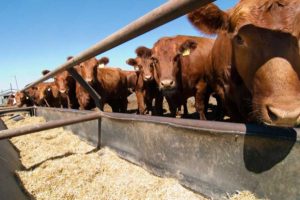Shiga toxin-producing Escherichia coli (STEC) strains can colonize cattle for several months and may, thus, serve as gene reservoirs for the genesis of highly virulent zoonotic enterohemorrhagic E. coli (EHEC).
 Attempts to reduce the human risk for acquiring EHEC infections should include strategies to control such STEC strains persisting in cattle. We therefore aimed to identify genetic patterns associated with the STEC colonization type in the bovine host. We included 88 persistent colonizing STEC (STECper) (shedding for ≥4 months) and 74 sporadically colonizing STEC (STECspo) (shedding for ≤2 months) isolates from cattle and 16 bovine STEC isolates with unknown colonization types. Genoserotypes and multilocus sequence types (MLSTs) were determined, and the isolates were probed with a DNA microarray for virulence-associated genes (VAGs). All STECper isolates belonged to only four genoserotypes (O26:H11, O156:H25, O165:H25, O182:H25), which formed three genetic clusters (ST21/396/1705, ST300/688, ST119). In contrast, STECspo isolates were scattered among 28 genoserotypes and 30 MLSTs, with O157:H7 (ST11) and O6:H49 (ST1079) being the most prevalent. The microarray analysis identified 139 unique gene patterns that clustered with the genoserotypes and MLSTs of the strains. While the STECper isolates possessed heterogeneous phylogenetic backgrounds, the accessory genome clustered these isolates together, separating them from the STECspo isolates.
Attempts to reduce the human risk for acquiring EHEC infections should include strategies to control such STEC strains persisting in cattle. We therefore aimed to identify genetic patterns associated with the STEC colonization type in the bovine host. We included 88 persistent colonizing STEC (STECper) (shedding for ≥4 months) and 74 sporadically colonizing STEC (STECspo) (shedding for ≤2 months) isolates from cattle and 16 bovine STEC isolates with unknown colonization types. Genoserotypes and multilocus sequence types (MLSTs) were determined, and the isolates were probed with a DNA microarray for virulence-associated genes (VAGs). All STECper isolates belonged to only four genoserotypes (O26:H11, O156:H25, O165:H25, O182:H25), which formed three genetic clusters (ST21/396/1705, ST300/688, ST119). In contrast, STECspo isolates were scattered among 28 genoserotypes and 30 MLSTs, with O157:H7 (ST11) and O6:H49 (ST1079) being the most prevalent. The microarray analysis identified 139 unique gene patterns that clustered with the genoserotypes and MLSTs of the strains. While the STECper isolates possessed heterogeneous phylogenetic backgrounds, the accessory genome clustered these isolates together, separating them from the STECspo isolates.
Given the vast genetic heterogeneity of bovine STEC strains, defining the genetic patterns distinguishing STECper from STECspo isolates will facilitate the targeted design of new intervention strategies to counteract these zoonotic pathogens at the farm level.
The accessory genome of Shiga toxin-producing Escherichia coli defines a persistent colonization type in cattle
Appl Environ Microbiol 82:5455–5464. doi:10.1128/AEM.00909-16.
SA Barth, C Menge, I Eichhorn, T Semmier, LH Wieler, D Pickard, A Belka, C Berens, L Geue
